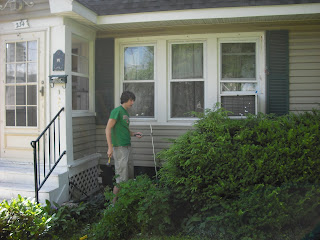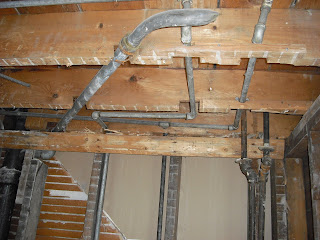 |
| 2005 Prius |
We drive a hybrid Prius car. In March 2005, we bought a 2005, generation II Prius. We now have 110,000 miles as of November, 2010. I had first seen a Prius at the New York State Fair about 3 years earlier. I had talked to the salesman, and was shown around the car. My car at the time was a Saturn 4 door, with a manual transmission. We also had a second car, a station wagon that my wife and later my kids drove. I couldn't get them interested in the stick shift, it was too complicated, though thru our first 3 cars together, my wife Ginny and I had had manual transmission cars.
So when we needed a replacement for the Saturn in 2005, we were looking for a $10,000 used car. We ended up buying a $23,000 Toyota Prius.
What Mileage do we get? About 45 to 50 miles per gallon in the summer, and as low as 35 to 40 miles per gallon in the winter. Some items that reduce miles per gallon: electric air conditioning system, electric heat in the winter. Driving into the wind going west to Rochester, and driving with the wind behind us coming back to Syracuse, gives a swing of 40 mpg going west, and 50 mpg coming back east. Going up hills, and we have very low mileage. Going down hills, the generator recharges the battery. Stopped in Traffic, the engine will shut off. When the brakes are applies, the regenerative braking system charges the battery.
The car is not electric, it runs on gas. There is an electric motor, but the battery for the motor is charged by the gasoline engine. I still have to fill the tank with gas.
The car does have quirks. When my brother rented a prius, he called me up one morning to say he couldn't get the car in gear. I think this happens to us all, you need to press down the start button while simultaneously stepping on the brake to start the car. The car also makes noises after it is shut off.
Sneaky, is a description of a Prius. When it runs on electric, there is no noise. People often will walk right in front of us on city streets, not hearing the car.
This car is our first Toyota, and we are very pleased with the performance of the car. We needed new brakes at 80,000 miles. Other problems have been minimal.
Price of Gas, when we first bought our Prius, gas was under $3 per gallon. We were told the breakeven gas price for the additional cost of a hybrid was $3 per gallon. Since then the price has gone up to $4, and down to $2.65, now back up to $3 per gallon.
The car has done well in snow. A few years ago, while visiting in the Catskill mountains, about 6" of snow fell overnight. Our other car, a station wagon, had a hard time making it out of the long driveway. Our Prius went right up with no problem, it is a heavier car than one would think and had good traction.
 |
| Pushbutton start, touch screen climate control and radio tuning |




































